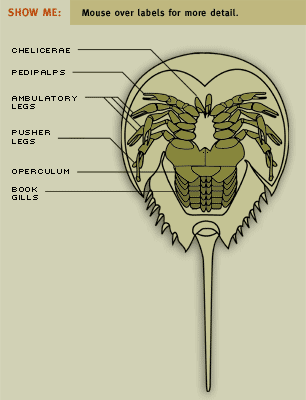Topographic Characteristics
A look at the underside of the horseshoe reveals six paired appendages. The horseshoe uses the first pair (the chelicera) for placing food in its mouth. The next pair of appendages are the pedipalps; these are the first ambulatory legs. In the adult male, the tarsus of these legs are modified as a grasping appendage, allowing males to clasp the female during spawning. The "last" legs are the "pusher" legs, used for locomotion. Looking closely at this appendage (mouse over the label for detail), there is a spatulate organ that forms part of the leg, called the flabellum, whose function is to test the composition of the water passing to the gill chamber.
Towards the tail are five branchial "legs" which are commonly called the book gills. (Click here for a microscopic view.) The horseshoe uses them both for propulsion when swimming and for "breathing". Similar to the gills in a fish, they are a membrane that allows oxygen to pass through while keeping the water out. Interestingly, the crab CAN absorb water through the book gills; it does this during each molt to expand the shell.
The first pair of the 6 book gills is called the operculum, and it serves as a cover for the other five pairs, which are the respiratory organs. In addition, the operculum houses the opening of the genital pores through which eggs and sperm are released from the body. The hemolymph (a loose equivalent to blood) flows through the multiple pages (or lamellae) of the ten books.

Illustration (modified) by Carl Shuster